

Original Article - Year 2012 - Volume 27 -
Epidemiological profile of scalping victim-patients treated at the Fundação Santa Casa de Misericórdia do Pará
Perfil epidemiológico de pacientes vítimas de escalpelamento tratados na Fundação Santa Casa de Misericórdia do Pará
ABSTRACT
BACKGROUND: Scalping is a trauma caused by partial or total avulsion of the scalp. It is primarily due to accidental contact of long hair with the rotary shaft of a motor. Rotary shafts suck in the victim's hair, causing traction and abruptly pulling the scalp off.
METHODS: A longitudinal, observational, retrospective, and descriptive study of 62 scalping victim-patients treated at Fundação Santa Casa de Misericórdia do Pará was conducted.
RESULTS: The most commonly affected patients were children between 7 and 16 years of age (56.4%) and women (93.5%); 59.7% were students and 43.5% were Catholics.
CONCLUSIONS: Prophylactic campaigns about the risks of traveling in and maintaining a vessel without motor shaft protection are essential because scalping is primarily caused by hair twisting around the motor shaft.
Keywords: Scalp. Wounds and injuries. Accident prevention.
RESUMO
INTRODUÇÃO: Escalpelamento é trauma causado por avulsão parcial ou total do couro cabeludo, decorrente, principalmente, de contato acidental dos cabelos longos com motor de eixo rotativo. A alta rotação desses motores gera uma força que suga os cabelos da vítima, tracionando e arrancando o couro cabeludo de forma abrupta.
MÉTODO: Foi realizado um estudo observacional transversal, retrospectivo, descritivo, incluindo 62 pacientes vítimas de escalpelamento tratados na Fundação Santa Casa de Misericórdia do Pará.
RESULTADOS: Os pacientes mais acometidos foram crianças de 7 anos a 16 anos (56,4%), do gênero feminino (93,5%), sendo 59,7% estudantes e que, predominantemente, praticavam a religião católica (43,5%).
CONCLUSÕES: Campanhas profiláticas sobre os riscos de se viajar e manter uma embarcação sem proteção no eixo do motor são fundamentais, uma vez que a tragédia do escalpelamento é causada principalmente pelos cabelos que se enrolam no eixo do motor.
Palavras-chave: Couro cabeludo. Ferimentos e lesões. Prevenção de acidentes.
Scalping is a common trauma in the northern region of Brazil that is caused by partial or total avulsion of the scalp. In this region, scalping occurs mainly due to long hair being accidentally caught in the motor rotary shaft of boats, generating rotary traction force, leading to abrupt scalping1,2.
According to the data provided by the Fundação Santa Casa de Misericórdia do Pará (FSCMP), there were scalping cases in 44 municipalities of the State of Pará between 1979 and 2007; the areas with most reported scalping cases include the municipalities of Belém (and its islands) and the cities of Breves and Cametá3.
The high incidence of accidents in this region is due to some factors. In general, boat motors here do not have safety devices preventing users from coming into contact with them. Thus, the fast rotation of the motor shaft sucks light elements into it4. In addition, the women in that region have a cultural preference for long and loose hair.
In general, scalping is a traumatic accident, causing hemodynamic impairment and intense pain. The clinical presentation also involves secondary myalgia in adjacent regions; edema and hematomas in the facial region; restricted movement of the face, neck, and scapular girdles; and tension headache1,2.
Such accidents generate physical sequelae as well as intense psychological and sociological suffering throughout the treatment and over patients' lives since it can significantly damage their self-esteem, identity, body perception, humor, sociability, and affective relationships with others. In addition, it can affect family dynamics and economic affairs3.
From an anatomic perspective, among the traction lines from which the scalp can be pulled off, the most common are the scalp junction lines with the facial and neck skin where the skin is thinner and more tightly adhered. Thus, if the hair is initially subjected to traction in the occipital region, the skin first breaks at the forehead; the opposite occurs if it is first subjected to traction in the forehead. If the whole hair is subjected to traction simultaneously, the skin initially breaks at the eyebrows followed by the zygoma line, above and around the ears or through them, and finishing at the nape (Figure 1). In addition to soft tissue involvement, the skullcap may be exposed, followed by ischemic necrosis, osteitis, and/or bone sequestration2.
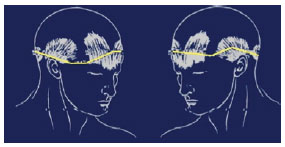
Figure 1 - Regions that suffer avulsion due to the simultaneous traction of all hair.
At present, there are few data in the literature about the treatment of the consequences of this type of accident, which is relatively common in the Amazon region. In addition, it is important to update information to determine the incidence of scalping in this region.
This study aims to track the epidemiological profiles of individual scalping victims admitted at FSCMP from 2001 to 2010.
METHODS
A longitudinal, observational, retrospective, and descriptive study of 62 scalping victim-patients treated at FSCMP from 2001 to 2010 was conducted.
Several sociodemographic variables, injury aspects, complications, treatment, and scalping cause were collected and analyzed.
The study was conducted after approval by the Ethics in Human Beings Research Committee of the Institution. Data were collected from medical records, according to the research protocol.
RESULTS
Epidemiological aspects
Of the 62 scalping victim-patients between 2001 and 2010, 58 (93.5%) were women. Fifteen (24.2%), 4 (6.5%), and 43 (69.3%) were Blacks, Whites, and of undeclared race, respectively. Table 1 presents the distribution of patients by age.
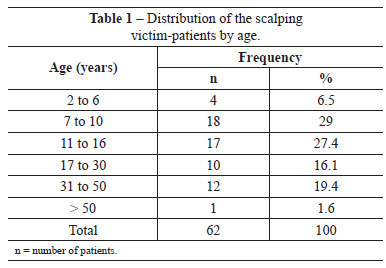
Regarding profession/occupation, 37 (59.7%), 7 (11.3%), 6 (9.7%), 1 (1.6%), and 11 (17.7%) were students, housewives, landsmen, teachers, and undeclared, respectively.
Regarding religion, 27 (43.5%) and 20 (32.3%) declared being Catholic and Protestant, respectively; the religions of 15 (24.2%) patients were not in the medical records.
The distribution of patients by municipality is presented in Table 2.
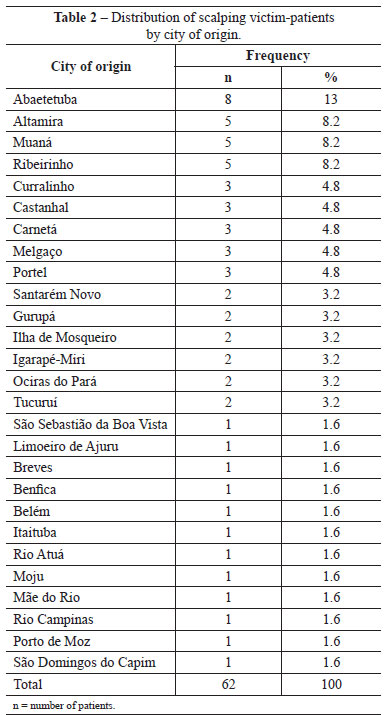
Regarding first attendance, 9 (14.5%) patients were admitted to local hospitals near the accident site; meanwhile, in 37 (59.7%) patients, the admission to hospitals and the accident occurred at different locations. In all other cases, there was no relevant information in the medical records. In total, 26 (41.9%), 14 (22.6%), 3 (4.8%), 2 (3.2%), and 1 patient (1.6%) received primary care in Belém, Ananindeua, Altamira, Itaituba, and Cametá, respectively; data were unavailable for 16 (25.9%) patients.
Most scalping cases were due to accidents involving vessels in addition to animal bites, wounds caused by sharp weapons, work accidents, and vehicular collisions (Table 3).
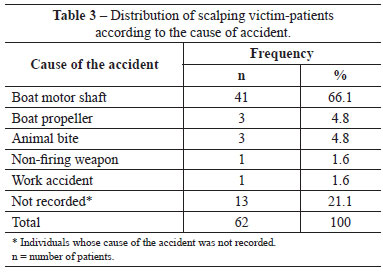
Clinical and surgical aspects
Regarding the wound characteristics upon initial admission, 19 (30.6%), 15 (22.4%), 1 (1.6%), and 1 (1.6%) patient presented with bone tissue exposure, granulomatous tissue, necrotic tissue, and skull fracture, respectively; no initial wound characteristics were available for 35 (56.5%) patients.
Table 4 presents the incidence of complications of the scalping victims.
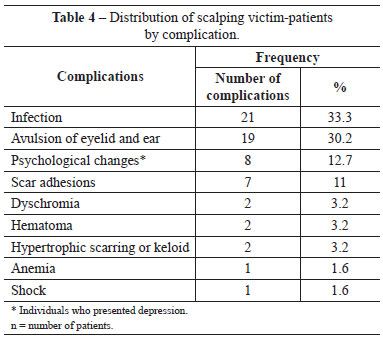
Treatment aspects
Table 5 presents the surgical procedures carried out and their frequency. Microsurgical reimplantation was not performed in any of the cases. Among the grafts, the thigh and retroauricular region were the donor regions in 42 (32.3%) and 3 (2.3%) cases, respectively; no data were available for the other cases (65.4%).
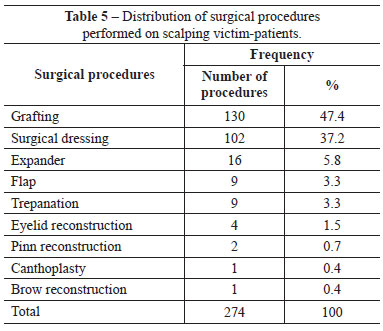
All patients were treated with analgesics, including dipirona, paracetamol, tramal, and profenid in 49 (79%), 13 (21%), 8 (12.9%), and 7 (11.3%) patients, respectively. In addition, antibiotics were prescribed to all patients: penicillin in 27 (43.5%), first-generation cephalosporins in 24 (38.7%), second-generation cephalosporins in 22 (35.5%), aminoglycosides in 11 (17.7%), glycopeptides in 7 (11.3%), lincosamide in 3 (4.8%), quinolone in 2 (3.2%), carbapenems in 2 (3.2%), and sulfonamide in 1 (1.6%). Antiprotozoals were administered in 2 (3.2%) patients. Blood transfusion was performed in 1 (1.6%) patient.
DISCUSSION
Regarding the sociodemographic characteristics of the study population, children aged 7 to 10 years (29%) were predominantly affected, which is concordant with the findings of a previous study conducted in the Amazon region5; children commonly travel in boats not only as passengers, but as pilot assistants as well. Such accidents in children are life altering; children present several symptoms and are treated with prejudice, making it difficult to maintain their lives due to intense psychological suffering. Some victims stop studying and move away from their homes, isolating themselves from family and friends.
With respect to gender, the present results are concordant with those of a previous study reporting the predominance of female victims (93.5%), which is likely due to cultural and religious factors; Amazonian women almost always have long hair. However, the present data are not concordant those of with previous studies with respect to religion; 43.5% of patients were Catholic in the present study, while a previous study1 indicates a predominance of Protestant women due to the religious influence toward having long hair.
The predominance of patients from the interiors of Brazil, especially Abaetetuba with 13% of patients, is likely due to the great number of rivers in the Amazon Basin and lack of roads in this region, making river transportation routine. In addition, inspection by competent agencies regarding the protection of the motor shafts of boats, which are generally unprotected4, is difficult due to the great distances between places as well as the large numbers of uninspected vessels6.
After their accidents, most patients usually went to metropolitan regions such as Belém and Ananindeua for primary care, meaning that 59.7% received primary care in locations other than the accident site. This is probably because people from the interiors of Brazil have access to limited health infrastructure6.
Although it is the ideal treatment, it was impossible to perform microsurgical reimplantation of the scalp in all cases due to the delay in getting to specialized treatment centers7.
From a clinical/surgical perspective, bone exposure was the main characteristic of injuries and was present in 30.7% of the studied cases. Only 1 (1.6%) case of necrotic tissue was found; this differs from previous studies8,9 that reports it as a frequent characteristic in scalping injuries in addition to ischemic necrosis, osteitis, and bone sequestration2. In all recorded cases, patients underwent debridement during the first admission. The lack of recorded information is the reason for the poor characterization of wounds (56.5% of the cases).
The involvement of the frontal and lower facial regions as well as the detachment of the eyelids and ears are complications arising from scalping4,10. Existing data corroborate the findings of the present study in that the main complication of scalping is infection followed by avulsion of the eyelids and ears. As described in the literature, it is known that together with scalp injuries, these complications frequently lead to motor impairment if they affect muscles and ligaments.
Among the patients in this study, 33.3% presented with an infectious outline. The difficulty many patients face getting to larger cities for effective treatment can be attributed to large intercity distances and limited access to roads. These factors likely contribute to the fact that patients arrive at the hospital with signs of infection, fever, and purulent secretion from the wound6.
Among the surgical procedures, 47.4% were grafts with the thigh being used most often (Figures 2 and 3); however, in some cases such as partial avulsions, the remaining scalp itself was used as the donor region due to its rapid healing ability and better esthetic results6. In addition, the abdomen, upper eyelids, and legs and antecubital, inguinal, retroauricular, and supraclavicular flexor folds can be used as graft donor areas. Thick skin grafts offer better results than thin ones since they are more stable and resistant to trauma, although they require laborious fixation. Although very efficient for treating this type of trauma, flaps were used only in 3.3% of the cases, possibly due to the large extent of the injuries. Rotation flaps may efficiently distribute the tension and provide closure of small defects with no need for skin grafts in the donor area4.
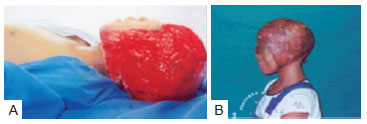
Figure 2 - In A, total scalp avulsion. In B, post-grafting aspect.
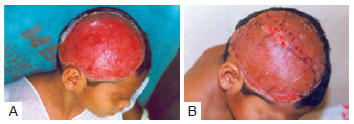
Figure 3 - In A, partial scalp avulsion. In B, post-grafting aspect.
Some authors recommend the use of expanders in patients with partial scalping, which comprised 5.8% of the surgical procedures in this study11 (Figure 4). In children, expanders were applied to patients older than 3 years of age since their skull structures are already consolidated. Despite the good esthetic results, cases like these require longer and more expensive treatment12.
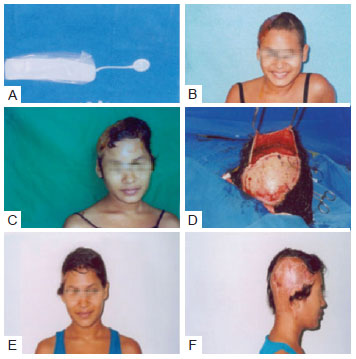
Figure 4 - In A, tissue expander. In B, partial scalping after grafting (previous view). In C, patient in the expansion period. In D, expanded flap. In E, postoperative view of the expanded flap (previous view). In F, postoperative view of the expanded flap (side view).
With respect to drug treatment, antibiotic therapy is recommended as the initial procedure in addition to analgesics and anti-tetanus drugs1. Penicillin and first- and second-generation cephalosporins were the most commonly used antibiotics. Antibiotics and analgesics were administered after hospitalization in all studied cases, usually continuing after discharge.
Eight patients exhibited depressive symptoms as accident complications. Despite the relatively low percentage of these symptoms (12.9%), it requires attention because the psychological and social suffering of these patients is often greater than the physical trauma and may even last after treatment; this can result in damage to the patient's self-esteem and ability to socialize and maintain good affective relationships3,13. Moreover, income is related to the psychological trauma experienced by scalping victims, considering that such patients face difficulties participating in society and the labor market due to their physical appearance.
CONCLUSIONS
In the Amazon region, since scalping is primarily caused by hair twisting around the motor shafts of boats, it is important to promote awareness of this issue through prophylactic campaigns about the risks of traveling and maintaining a vessel without motor shaft protection, directed toward boat owners and operators. When effective, the treatment of scalping victims, who are mainly women and children, is long since; it involves several reparative surgeries in addition to psychological treatment due to esthetic sequelae and resultant social problems. Therefore, it is extremely important that local governments take initiatives to prevent such accidents and provide efficient primary care for victims.
REFERENCES
1. Britto CBL, Normando Júnior GR, Fonseca CCF, Aita V, Pinheiro Filho A. Escalpelamento na população amazônica. Rev Para Med. 2004;18(2):35-8.
2. Freitas RS, Cruz GAO, Fagotti Filho A, Alonso N. Reconstrução de orelha utilizando uma única cartilagem costal: descrição modificada da técnica. Rev Soc Bras Cir Craniomaxilofac. 2005;8(2):39-47.
3. Ribeiro NS. Necessidade e dilemas das famílias vítimas de escalpelamento atendidas na FSCMP: desafios para o serviço social [trabalho de conclusão de curso]. Belém: Universidade Federal do Pará; 2009.
4. Mota MA. A contribuição da fisioterapia no tratamento das vitimas de escalpelamento [trabalho de conclusão de curso]. Belém: Universidade Estadual do Pará; 2000.
5. Vale JCC. A compreensão do sofrimento no escalpelamento: um estudo utilizando o grafismo e o teste das fábulas [dissertação de mestrado]. Belém: Universidade Federal do Pará; 2007.
6. Menezes MLCP. Análise epidemiológica e tratamento cirúrgico das avulsões de couro cabeludo por acidente em barcos [trabalho apresentado ao exame de membro titular da Sociedade Brasileira de Cirurgia Plástica]. Belém: Sociedade Brasileira de Cirurgia Plástica; 2003. p. 34-9.
7. Milcheski DA, Cheroto Filho A, Goldenberg DC, Farias JC, Ferreira MC. Reimplante microcirúrgico das avulsões de couro cabeludo: experiência de 7 anos. Rev Soc Bras Cir Plást. 2003;18(3):47-54.
8. Kazanjian VH, Webster RC. The treatment of extensive losses of the scalp. Plast Reconstr Surg. 1946;1(3):360-85.
9. Koss N, Robson MC, Krizek TJ. Scalping injury. Plast Reconstr Surg. 1975;55(4):439-44.
10. Burmann TG, Marcon Í, Rizzato T, Scheid K. Reconstrução marginal de pálpebras utilizando enxerto de palato duro. Arq Bras Oftalmol. 2008;71(4):514-7.
11. Vale EA. Correção de escalpe com a expansão tecidual prévia: relato de caso. In: Tournieux AA, ed. Atualização em cirurgia plástica III. São Paulo: Robe Editorial; 1999. p. 81-2.
12. Hochberg J, Pereira K, Almeida MA. Expansores cutâneos. In: Hochberg J, ed. Retalhos. Rio de Janeiro: MEDSI; 1990. p. 845-74.
13. Beckman KAF, Santos NCM. Terapia ocupacional: relato de caso com vítima de escalpelamento por eixo de motor de barco. Cad Ter Ocupac UFSCar. 2004;12(1):20-43.
1. Medical Student, President of Liga Acadêmica de Cirurgia Plástica do Pará (Academic League for Plastic Surgery of Pará), Belém, PA, Brazil.
2. Medical Student, Belém, PA, Brazil.
3. Medical Student, Training Coordinator of Liga Acadêmica de Cirurgia Plástica do Pará (Academic League for Plastic Surgery of Pará), Belém, PA, Brazil.
4. Medical Student, Communication Coordinator of Liga Acadêmica de Cirurgia Plástica do Pará (Academic League for Plastic Surgery of Pará), Belém, PA, Brazil.
5. Full Member of the Sociedade Brasileira de Cirurgia Plástica (Brazilian Plastic Surgery Society) - SBCP, Associate Professor in Plastic Surgery from Faculdade de Medicina da Universidade de São Paulo, Assistant Physician at the Hospital das Clínicas da Faculdade de Medicina da Universidade de São Paulo, São Paulo, SP, Brazil.
6. Full Member of the SBCP, Belém, PA, Brazil.
Maria Lastenia Chagas Primo Menezes
Av. Conselheiro Furtado, 2.865 - Ed. Síntese 21, sobreloja 6
Belém, PA, Brazil - CEP 66063-060
E-mail: consultoriolastenia@gmail.com, lastenia@amazon.com.br
Submitted to SGP (Sistema de Gestão de Publicações/Manager Publications System) of RBCP (Revista Brasileira de Cirurgia Plástica/Brazilian Journal of Plastic Surgery).
Article received: December 9, 2011
Article accepted: January 18, 2012
Study conducted at the Fundação Santa Casa de Misericórdia do Pará, Belém, PA, Brazil.


 Read in Portuguese
Read in Portuguese
 Read in English
Read in English
 PDF PT
PDF PT
 Print
Print
 Send this article by email
Send this article by email
 How to Cite
How to Cite
 Mendeley
Mendeley
 Pocket
Pocket
 Twitter
Twitter